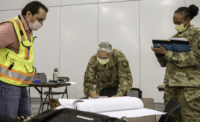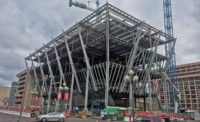In the early 1980s, the leadership of the Birmingham, Ala.-based construction firm that would become Robins & Morton made a strategic decision—move away from hard bids in favor of negotiated contracts with its clients, most of which were health care companies.
“That was a big milestone for us,” recalls Bill Morton, chairman and CEO and the son of former president and part-owner Barry Morton, whose name was added to the original Robins Corp. in 1992. “We wanted to partner with our clients and build more collaboratively.”
Being an early adopter of what has become an industry-wide practice has allowed Robins & Morton to flourish in its core health care market, which makes up 80% of its business, as well as in the hospitality and government sectors. Combined with an overall strong Southeast economy, the company has enjoyed several consecutive years of solid growth. For 2018, Robins & Morton’s regional revenue of just under $920 million marked a 10% increase from its 2017 revenue total—which itself had grown 26.1% over 2016’s total. Robins & Morton currently ranks 11th among the region’s contractors.
The company reports that a third of that volume came from Florida, as evidenced by the recently completed $145-million tower addition and renovation project at Mount Sinai Medical Center in Miami Beach; a $76-million, 92-bed vertical expansion at Tradition Medical Center in Port St. Lucie; and the Mayo Clinic’s new $56-million cancer treatment center in Jacksonville. Last year also saw Robins & Morton working on a $158.2-million tower and central energy plant expansion at Baptist Hospital of Miami.
Morton notes that 90% of the firm’s revenue is repeat business, “and those clients are growing.”
Among them is Huntsville Hospital in Huntsville, Ala., where the contractor is currently constructing a $175-million orthopedic and spine tower. Rudy Hornsby, senior vice president for operations, estimates that of the “hundreds of projects” Robins & Morton has handled over the past 28 years, the contractor missed budget and schedule no more than twice.
Hornsby also remembers well the challenges of project management in the days before Huntsville Hospital adopted integrated project delivery with Robins & Morton. Doing projects piecemeal, he recalls, “was very hard to manage.”
By building primarily for and around the health care industry, Robins & Morton has become well versed in the intricacies of health care construction and renovation work, from carefully staging work around existing critical operations to retaining the flexibility to accommodate last-minute decisions on high-tech equipment.
“Specialized medical technology changes so quickly, and physicians want the latest advancements on hand when the facility opens,” says Robin Savage, president and COO. “You have to be adaptable.”
Jacob Nagib, director of planning, engineering and construction for Daytona Beach, Fla.-based Halifax Health, credits Robins & Morton for cultivating a full understanding of health care construction issues across its project team.
“You get comfortable with them as a project goes along because they know everything,” says Nagib, who is currently overseeing Robins & Morton’s work on a 196,000-sq-ft addition at Halifax Crossing Hospital in Deltona, Fla. “They can also work directly with the facility’s users because they know what those challenges are, and what it takes to address them.”
Internal innovation
Along with becoming closely acquainted with its clients’ complex needs, Robins & Morton has sought to address internal resource challenges shared by contractors of all sizes and specialties.
In addition to supporting the work of the Birmingham Academy of Craft Training, which recruits and trains high school students for construction careers, the company’s Craft Mentorship program helps current craft-level employees prepare for management roles. The 15-week classroom and hands-on training course covers scheduling, leadership, cost control, estimating and other tools necessary to advance in the industry.
The program is highly selective, Savage adds, accepting fewer than half of the more than 20 applicants. Members of last year’s inaugural graduating class were promoted to foreman or assistant superintendent. The next class graduates this coming July.
“We see this as a real breeding ground for craft-based superintendents of the future,” Savage says, adding that the company has also invested in improving craftworker benefits, including paid time off, financial advising and assistance in transitioning between assignments.
Another new training initiative aims to shift the company’s safety effort to reflect a human performance approach by seeking to understand the underlying systematic factors that shape workers’ behaviors and actions. Savage says the approach is already having a positive effect on jobsite safety education and what employees should be watching for from a systems perspective.
“We really see this as the wave of the future for making the jobsite safer,” he says, adding that the approach may also be adapted to other parts of the company’s operations.
The new approach should enhance what is already a strong safety program. Robins & Morton was recently cited by the North Carolina Dept. of Labor and Safety by recording zero injuries or illnesses involving days away from work statewide for 1 million hours over the past eight years.
Another Robins & Morton training initiative that recently broke ground is the company’s new Field Lab for students in Auburn University’s Building Science Program. The 5,000-sq-ft metal building will provide a fully equipped environment for training in the full building process as well as a venue for research into new practices and technologies.
Focus on the Future
Along with making extensive use of robotic layouts, drones and laser scanning for its projects, Robins & Morton is also part of the growing trend among construction companies to cultivate its own technology products. Buildfore, a company-sponsored start-up formed in 2018 by three of its schedulers, has so far developed four user-friendly construction technology products aimed at improving efficiency, collaboration and communication across the entire building team.
One tool, SlatPlanner, was developed to augment the Last-Planner system with an analog interface to retain the physical collaboration that the company says is lost in a digital-heavy environment. Buildfore’s founders gave a presentation on applications of their scheduling products at ENR’s recent FutureTech conference in San Francisco.
While Robins & Morton is currently contemplating geographic expansion as well as vying for more complex projects such as pharmaceutical manufacturing facilities, Savage expects the company to stay close to its health care roots. He notes, however, that the forces driving that market are continually evolving.
“Health care has become very competitive, and facility renovations are increasingly important for a hospital’s image,” he says.
Another trend is the growth of behavioral hospitals that provide substance abuse services. Earlier this year, ground was broken on a 80,000-sq-ft crisis stabilization unit on the campus of Cherokee Indian Hospital in Cherokee, N.C. Scheduled for completion next summer, the two-story facility incorporates 31,000 sq ft of a former hospital building to provide treatments for substance abuse patients.
“We’ll also focus on the way clients want to deliver projects and continue to be adaptable to those needs,” adds Morton. A recently established second-tier planning group, made up of nearly 20 people from across the company is providing a variety of perspectives that are being integrated into the company’s overall strategic plan.
Calling the group “one of the bigger things we’ve done this year,” Morton says the group’s input “will help us meet needs of both clients and employees.”
The biggest thing Robins & Morton does for its clients, says Hornsby, is continue the practices of the past several decades.
“The few times there’ve been problems, they’ve stepped up to do something about it, which in turn builds trust,” he says. “It’s not often you get to a point where owner and contractor can both take each other at their word.”












Post a comment to this article
Report Abusive Comment